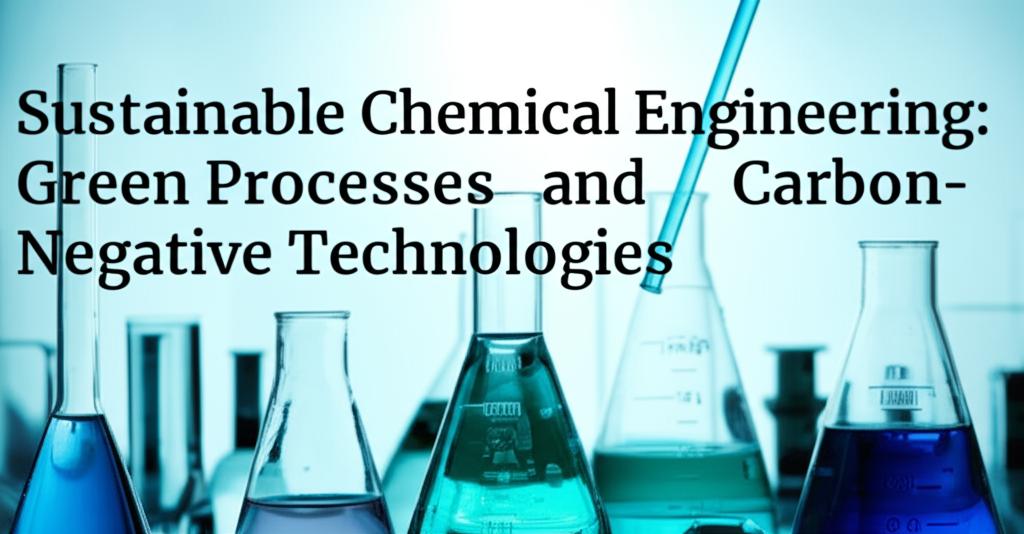The field of chemical engineering is rapidly evolving, driven by the urgent need for sustainable solutions to global challenges like climate change and resource depletion. This has led to a strong focus on green processes and the development of carbon-negative technologies.
Core Principles of Sustainable Chemical Engineering:At its heart, sustainable chemical engineering aims to design and implement chemical processes and products that minimize or eliminate the use and generation of hazardous substances. This involves:
- Minimizing Environmental Impact: Reducing pollution, waste generation, and energy consumption are primary goals. This includes designing products that are biodegradable or can be easily recycled.
- Resource Efficiency: Moving away from a "take-make-dispose" model towards a circular economy that emphasizes recycling, reusing materials, and recovering valuable chemicals.
- Safety: Ensuring processes are safer for both workers and surrounding communities.
Several key trends are shaping the development of greener chemical processes:
- Renewable Feedstocks: There's a significant shift away from fossil fuels towards renewable resources like biomass (plants, algae, agricultural waste) as starting materials for fuels and chemicals. The global renewable chemicals market is experiencing substantial growth.
- Green Chemistry: This involves finding safer, less toxic alternatives to harsh chemicals, particularly solvents. Water, ionic liquids (salts that are liquid at room temperature), and supercritical CO2 are being explored as greener solvent options.
- Catalysis: Developing highly efficient catalysts is crucial. Modern catalysts, often designed with atomic precision, can speed up reactions, allow them to occur at lower temperatures (saving energy), and increase product yield while minimizing waste. Enzyme engineering, using biological catalysts, is also a rapidly advancing area.
- Process Intensification: Designing more compact, efficient, and integrated processes that reduce equipment size, energy consumption, and waste.
- Bioprocessing and Biotechnology: Leveraging living organisms or their components to produce chemicals and materials. This includes the development of biofuels, bio-based plastics, and other biochemicals.
- Digitalization and Industry 4.0: Utilizing advanced sensors, data analytics, artificial intelligence (AI), and machine learning to monitor processes in real-time, optimize efficiency, predict maintenance needs, and reduce waste. Digital twins, virtual replicas of physical processes, allow for simulation and optimization before implementation.
- Eco-Friendly Packaging: Designing packaging with recycled or biodegradable materials to minimize environmental waste.
Beyond simply reducing emissions, the focus is increasingly on technologies that actively remove more carbon dioxide from the atmosphere than they emit during their lifecycle. This is crucial for achieving net-zero and eventually carbon-negative goals.
- Carbon Capture, Utilization, and Storage (CCUS): This involves capturing CO2 emissions from industrial sources or directly from the atmosphere.
Direct Air Capture (DAC): Technologies that extract CO2 directly from ambient air. While promising, DAC technologies currently face challenges in terms of energy efficiency and cost.
Bioenergy with Carbon Capture and Storage (BECCS): This process combines biomass energy production (burning biomass for heat or electricity) with capturing the CO2 released and storing it, resulting in a net removal of CO2 from the atmosphere.
- Carbon Conversion: Transforming captured CO2 into valuable products. Examples include:
Chemicals and Fuels: Scientists are engineering microbes to convert waste gases (like CO2 and carbon monoxide) into useful chemicals like acetone and isopropanol (IPA). This creates a circular carbon economy where waste carbon is recycled into new products.
Building Materials: Researchers are developing innovative methods to incorporate captured CO2 into building materials like concrete and cement. Some processes are inspired by natural systems like coral reefs, using electrochemistry to convert CO2 into carbonate minerals that can be part of strong, durable, and even fire-resistant construction materials. These materials can act as carbon sinks.
- Advanced Materials for Carbon Capture: Porous materials like Metal-Organic Frameworks (MOFs), zeolites, and carbon-based materials are being developed for more efficient CO2 adsorption. MOFs, in particular, show promise for their high capture efficiency even in challenging conditions.
- Alkaline Thermal Treatment (ATT) for Hydrogen Production: This emerging technology uses biomass to produce hydrogen, with the potential for negative carbon emissions when viewed across the entire lifecycle of the biomass.
While the progress in sustainable chemical engineering is significant, challenges remain. These include:
- Scaling Up Technologies: Many innovative green processes and carbon-negative technologies are still in the research and development or pilot stages. Scaling them up to industrial levels in a cost-effective manner is a major hurdle.
- Economic Viability: New sustainable technologies must be economically competitive with existing, often less environmentally friendly, processes.
- Infrastructure and Investment: Significant investment is needed in new infrastructure and in upskilling the workforce to implement these advanced technologies.
- Policy and Regulation: Supportive government policies and clear regulatory frameworks are essential to drive the transition towards sustainable chemical manufacturing.
The future of chemical engineering is intrinsically linked to sustainability. By embracing green chemistry principles, advancing process efficiency, and pioneering carbon-negative technologies, chemical engineers are playing a vital role in creating a more environmentally sound and economically resilient future. Continuous innovation, collaboration across disciplines, and a commitment to circular economy principles will be key to realizing the full potential of sustainable chemical engineering.

